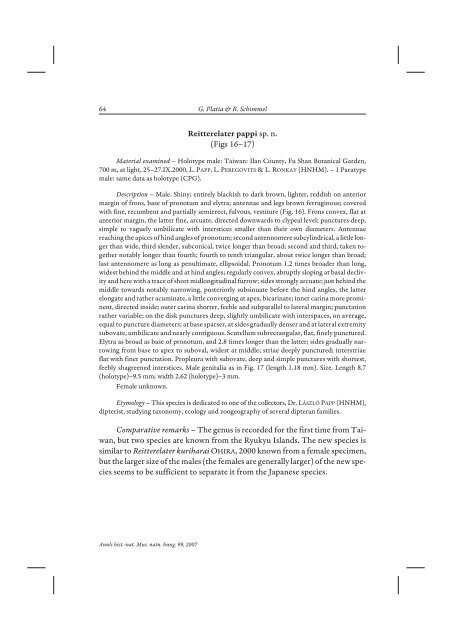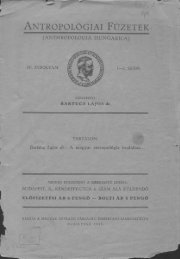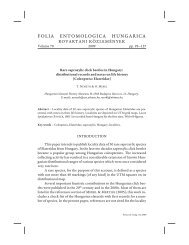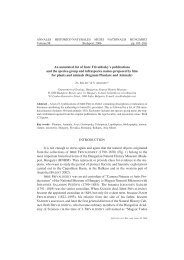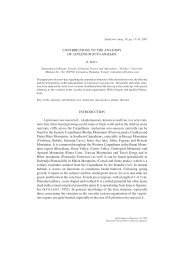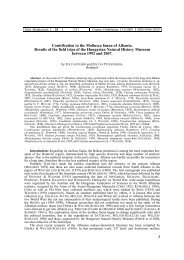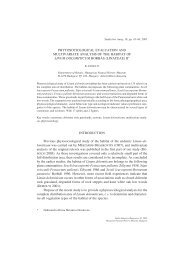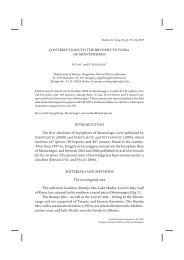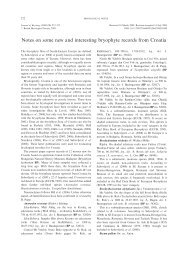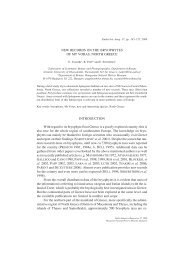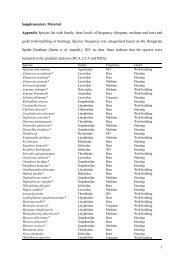You also want an ePaper? Increase the reach of your titles
YUMPU automatically turns print PDFs into web optimized ePapers that Google loves.
64 G. Platia & R. SchimmelReitterelater pappi sp. n.(Figs 16–17)Material exam<strong>in</strong>ed – Holotype male: Taiwan: Ilan County, Fu Shan Botanical Garden,700 m, at light, 25–27.IX.2000, L. PAPP,L.PEREGOVITS &L.RONKAY (HNHM). – 1 Paratypemale: same data as holotype (CPG).Description – Male. Sh<strong>in</strong>y; entirely blackish to dark brown, lighter, reddish on anteriormarg<strong>in</strong> of frons, base of pronotum and elytra; antennae and legs brown ferrug<strong>in</strong>ous; coveredwith f<strong>in</strong>e, recumbent and partially semierect, fulvous, vestiture (Fig. 16). Frons convex, flat atanterior marg<strong>in</strong>, the latter f<strong>in</strong>e, arcuate, directed downwards to clypeal level; punctures deep,simple to vaguely umbilicate with <strong>in</strong>terstices smaller than their own diameters. Antennaereach<strong>in</strong>g the apices of h<strong>in</strong>d angles of pronotum; second antennomere subcyl<strong>in</strong>drical, a little longerthan wide, third slender, subconical, twice longer than broad; second and third, taken togethernotably longer than fourth; fourth to tenth triangular, about twice longer than broad;last antennomere as long as penultimate, ellipsoidal. Pronotum 1.2 times broader than long,widest beh<strong>in</strong>d the middle and at h<strong>in</strong>d angles; regularly convex, abruptly slop<strong>in</strong>g at basal declivityand here with a trace of short midlongitud<strong>in</strong>al furrow; sides strongly arcuate; just beh<strong>in</strong>d themiddle towards notably narrow<strong>in</strong>g, posteriorly subs<strong>in</strong>uate before the h<strong>in</strong>d angles, the latterelongate and rather acum<strong>in</strong>ate, a little converg<strong>in</strong>g at apex, bicar<strong>in</strong>ate; <strong>in</strong>ner car<strong>in</strong>a more prom<strong>in</strong>ent,directed <strong>in</strong>side; outer car<strong>in</strong>a shorter, feeble and subparallel to lateral marg<strong>in</strong>; punctationrather variable; on the disk punctures deep, slightly umbilicate with <strong>in</strong>terspaces, on average,equal to puncture diameters; at base sparser, at sides gradually denser and at lateral extremitysubovate, umbilicate and nearly contiguous. Scutellum subrectangular, flat, f<strong>in</strong>ely punctured.Elytra as broad as base of pronotum, and 2.8 times longer than the latter; sides gradually narrow<strong>in</strong>gfrom base to apex to suboval, widest at middle; striae deeply punctured; <strong>in</strong>terstriaeflat with f<strong>in</strong>er punctation. Propleura with subovate, deep and simple punctures with shortest,feebly shagreened <strong>in</strong>terstices. Male genitalia as <strong>in</strong> Fig. 17 (length 1.18 mm). Size. Length 8.7(holotype)–9.5 mm; width 2.62 (holotype)–3 mm.Female unknown.Etymology – This species is dedicated to one of the collectors, Dr. LÁSZLÓ PAPP (HNHM),dipterist, study<strong>in</strong>g taxonomy, ecology and zoogeography of several dipteran families.Comparative remarks – The genus is recorded for the first time from Taiwan,but two species are known from the Ryukyu Islands. The new species issimilar to Reitterelater kuriharai OHIRA, 2000 known from a female specimen,but the larger size of the males (the females are generally larger) of the new speciesseems to be sufficient to separate it from the Japanese species.Annls hist.-nat. Mus. natn. hung. 99, 2007


